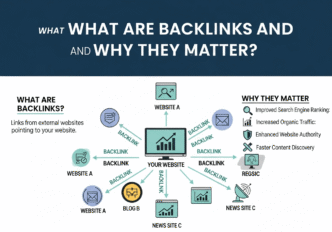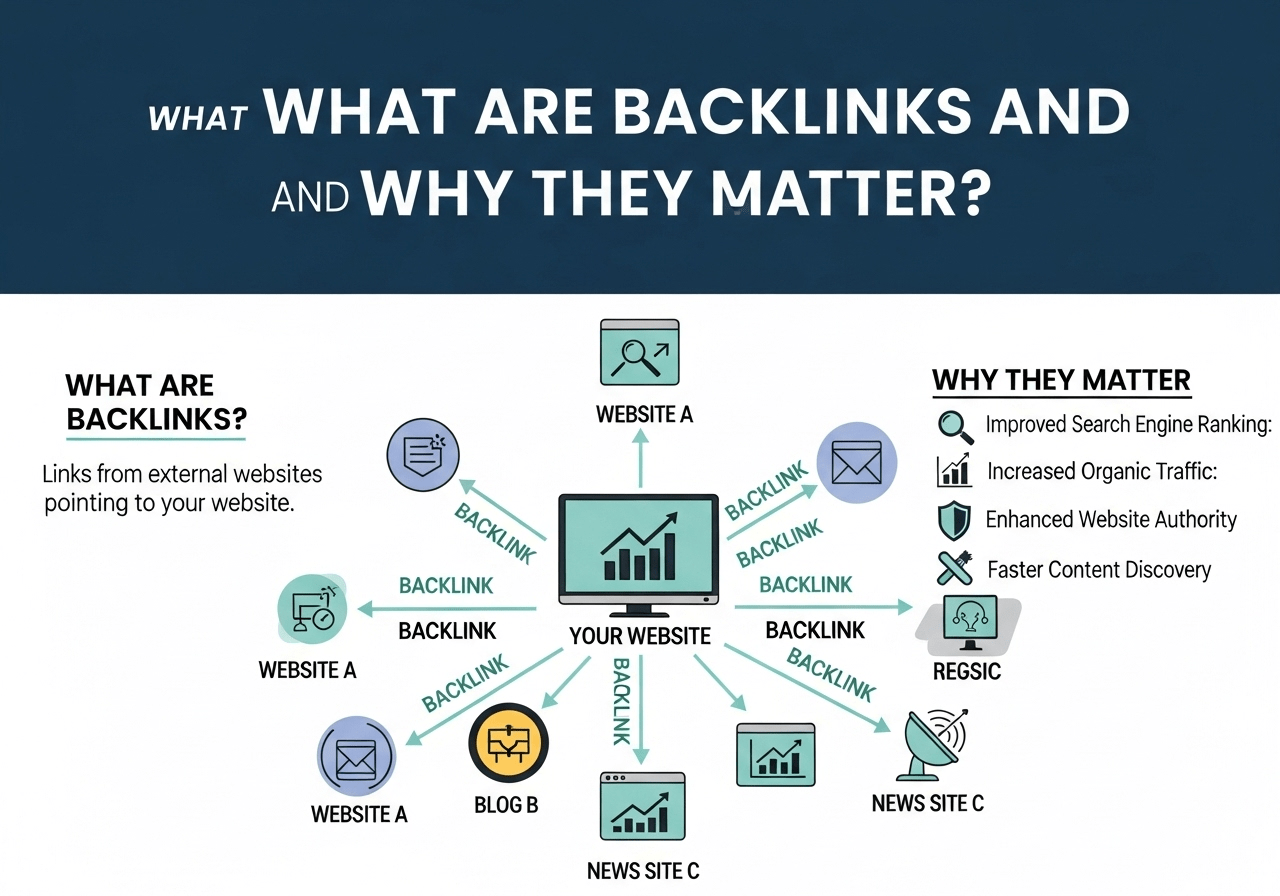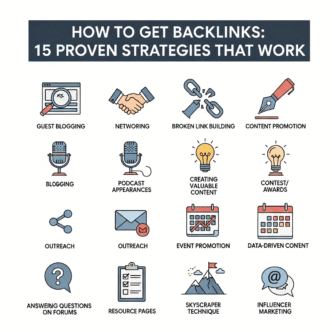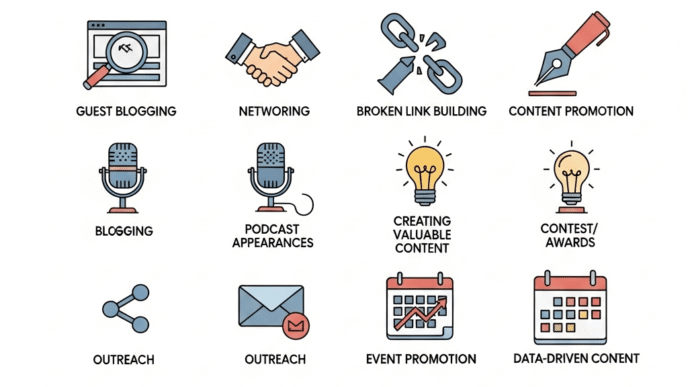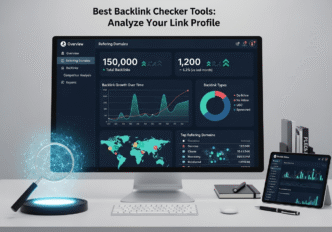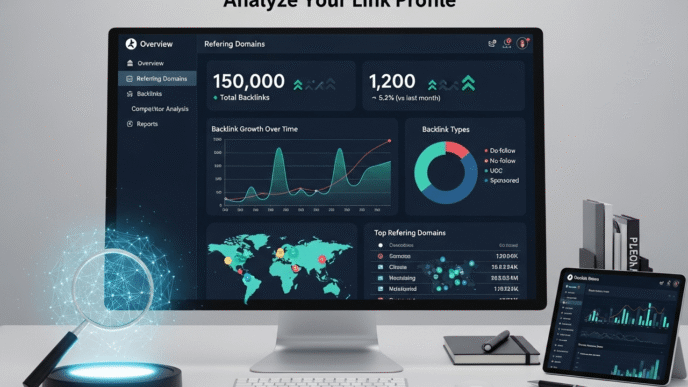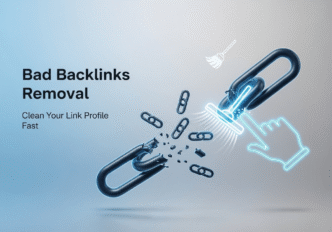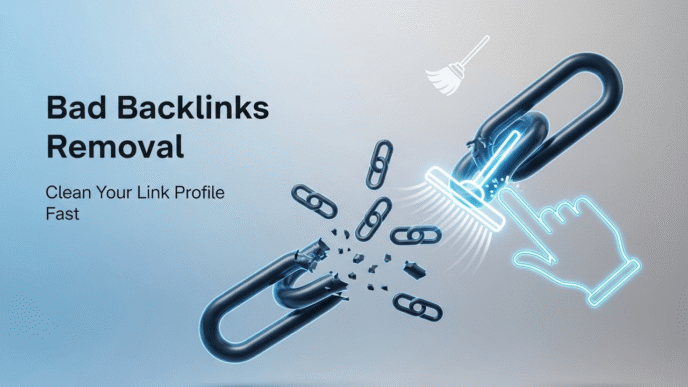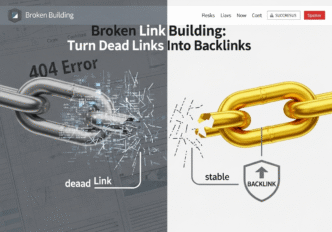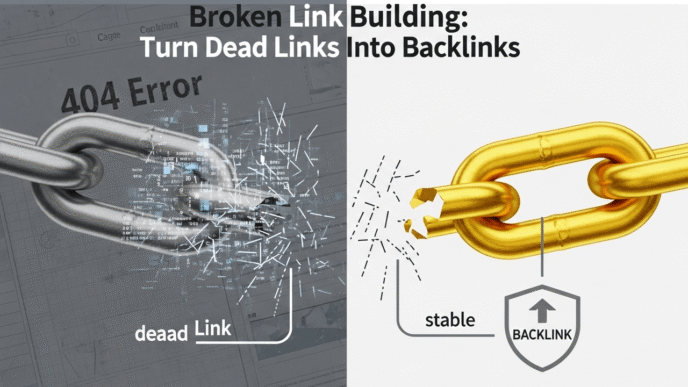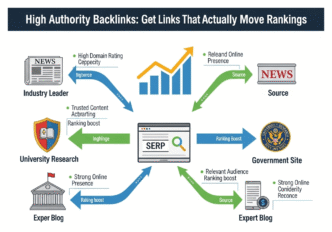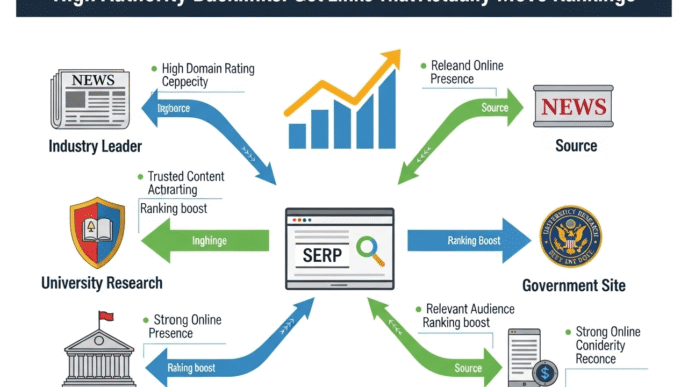Ever wondered why your competitor’s mediocre blog post ranks #1 while your masterpiece sits buried on page 47 of Google? The answer might be lurking in something called backlinks – those mysterious digital endorsements that can make or break your SEO dreams.
If you’ve ever scratched your head asking “what are backlinks” and why everyone in the SEO world obsesses over them like they’re digital gold, you’re in the right place. Think of backlinks as the internet’s version of word-of-mouth recommendations, except instead of your neighbor telling you about a great restaurant, it’s websites telling Google that your content deserves attention.
Understanding what backlinks are isn’t just SEO jargon – it’s the difference between having a website that gets found and having one that’s virtually invisible to your potential customers.
Table of Contents
Toggle
What Are Backlinks in SEO Explained: The Complete Definition
A backlink is simply a link from one website that points to another website. When Website A links to Website B, Website B has received a backlink from Website A. It’s like getting a referral or recommendation in the digital world.
Backlinks are also known by several other names that you’ll encounter in the SEO world:
- Inbound links (links coming into your site)
- External links (links from external websites)
- Incoming links
- One-way links
Think of backlinks like citations in academic papers. When a research paper cites another study, it’s essentially saying “this source is credible and supports my point.” Similarly, when a website links to your content, it’s telling search engines that your content is valuable and worth referencing.
The Anatomy of a Backlink
Every backlink has several key components:
Source Domain: The website that’s linking to you Target URL: The specific page on your site being linked to Anchor Text: The clickable text that contains the link Link Attributes: Technical tags like “nofollow” or “dofollow”
Pro Tip: “Not all backlinks are created equal. A single backlink from a high-authority website like The New York Times can be worth more than hundreds of links from low-quality directories. Focus on earning links from reputable sources in your industry rather than chasing quantity.”
How Do Backlinks Help SEO Rankings: The Google Connection
Backlinks serve as one of Google’s most important ranking factors because they act as votes of confidence. When authoritative websites link to your content, they’re essentially telling Google “this content is valuable and trustworthy.”
Google’s PageRank algorithm, which forms the foundation of how search results are ranked, was originally built around the concept of link authority. The more high-quality websites that link to your page, the more authority Google assigns to it.
The Trust Transfer Process
Here’s how backlinks influence your SEO rankings:
- Authority Transfer: High-authority websites pass some of their credibility to your site through link juice
- Relevance Signals: Links from topically relevant sites tell Google what your content is about
- Popularity Indicators: Multiple links suggest your content is popular and valuable
- Crawl Paths: Links help search engine crawlers discover and index your content
Real-World Example: The Skyscraper Technique Success
Brian Dean of Backlinko used a strategy called the “Skyscraper Technique” to earn 17,823 visitors and dozens of backlinks to a single blog post. He found popular content in his niche, created something significantly better, then reached out to websites that had linked to the original content.
The result? His comprehensive guide on “Google’s 200 Ranking Factors” attracted links from major publications and became one of the most referenced SEO resources online, demonstrating the direct connection between quality backlinks and increased traffic.
Types of Backlinks for Website SEO: Understanding the Categories
Not all backlinks are created equal. Understanding the different types helps you focus your link building efforts on the most valuable opportunities.
Dofollow vs. Nofollow Backlinks
| Link Type | Link Juice Transfer | SEO Value | When to Use |
|---|---|---|---|
| Dofollow | Yes | High | Editorial content, resource pages |
| Nofollow | No | Indirect | Paid links, user-generated content |
| Sponsored | No | Brand awareness | Paid partnerships, ads |
| UGC | No | Indirect | Comments, forums, reviews |
Editorial vs. Non-Editorial Links
Editorial Links: These are the holy grail of backlinks. They’re earned naturally when someone finds your content valuable enough to reference it organically. Examples include:
- Links from news articles
- References in blog posts
- Citations in research papers
- Mentions in industry reports
Non-Editorial Links: These are placed by you or requested through outreach:
- Directory submissions
- Profile links
- Footer links
- Signature links
High-Authority vs. Low-Authority Links
High-Authority Backlinks come from established, reputable websites with strong domain authority:
- Major news publications (CNN, BBC, The New York Times)
- Government websites (.gov domains)
- Educational institutions (.edu domains)
- Industry-leading publications
Low-Authority Backlinks come from newer or less established websites:
- Personal blogs
- New websites
- Low-traffic sites
- Spammy directories
Expert Insight: “I’ve seen single backlinks from sites like Harvard or The Wall Street Journal move a page from position 15 to position 3 within weeks. The authority and trust these domains carry is immense, and Google recognizes this immediately.”
Why Backlinks Are Important for SEO: The Multiple Benefits
Understanding why backlinks are important for SEO goes beyond just rankings. They provide multiple benefits that compound over time.
Direct SEO Benefits
Higher Search Rankings: Quality backlinks are still one of the top three ranking factors in Google’s algorithm, along with content quality and user experience signals.
Faster Indexing: When authoritative websites link to your new content, search engine crawlers discover and index it much faster than if you relied solely on sitemaps.
**Increased Domain Authority: As you accumulate quality backlinks, your website’s overall authority increases, making it easier for all your pages to rank.
Topic Authority: Links from relevant websites in your industry help establish your expertise and authority on specific topics.
Indirect Traffic Benefits
Referral Traffic: People clicking through backlinks become visitors to your website, often with high intent since they’re coming from relevant content.
Brand Exposure: Being mentioned and linked to by reputable websites increases brand awareness and credibility.
Networking Opportunities: Link building often leads to relationships with other industry professionals and potential collaboration opportunities.
Real-World Case Study: Local Business Success
A small Denver-based plumbing company increased their organic traffic by 340% in six months through strategic link building. Their approach:
- Created a comprehensive “Emergency Plumbing Checklist” guide
- Reached out to local news websites during winter freeze events
- Partnered with local real estate agents for content collaboration
- Got featured in home improvement blogs and local business directories
The result: 23 high-quality backlinks from local and industry-relevant websites, leading to first-page rankings for key plumbing terms in Denver and a significant increase in service calls.
Backlinks vs Internal Links Difference: Understanding Both Types
Many beginners confuse backlinks with internal links, but they serve different purposes in your SEO strategy.
Backlinks (External Links)
Backlinks come from other websites and point to your site:
- Source: External websites
- Purpose: Authority building, referral traffic
- Control: Limited (you can influence but not control)
- SEO Impact: High for rankings and authority
- Examples: Guest post links, editorial mentions, resource page listings
Internal Links
Internal links connect pages within your own website:
- Source: Your own website
- Purpose: User navigation, page authority distribution
- Control: Complete control
- SEO Impact: Helps with site structure and page authority distribution
- Examples: Menu links, related post links, contextual content links
How They Work Together
Backlinks bring authority to your domain, while internal links help distribute that authority throughout your website. Think of backlinks as bringing water to your garden, and internal links as the irrigation system that distributes that water to all your plants.
Strategic Tip: “Use your homepage and high-authority pages as link magnets to attract backlinks, then use strategic internal linking to pass that authority to your important commercial pages. This creates a powerful SEO ecosystem.”
Link Quality: What Makes a Backlink Valuable?
Not all backlinks provide the same SEO value. Understanding link quality factors helps you focus on earning the most valuable links.
Authority and Trust Signals
Domain Authority: Links from websites with high domain authority pass more link juice than those from low-authority sites.
Page Authority: The specific page linking to you should also have authority and relevance.
Trust Metrics: Google evaluates the trustworthiness of linking domains based on factors like:
- Age of the domain
- Content quality and frequency
- User engagement metrics
- Spam penalties history
Relevance and Context
Topical Relevance: Links from websites in your industry or niche carry more weight than random links.
Content Context: Links placed within relevant, high-quality content are more valuable than those in footers or sidebars.
Anchor Text: The clickable text should be natural and relevant, but not over-optimized with exact-match keywords.
Natural Link Patterns
Google looks for natural link building patterns:
- Diverse Sources: Links from various types of websites (news, blogs, directories, etc.)
- Varied Anchor Text: Mix of branded, generic, and keyword-rich anchor text
- Gradual Growth: Steady link acquisition over time rather than sudden spikes
- Geographic Distribution: For local businesses, a mix of local and national links
Referral Traffic: The Hidden Benefit of Quality Backlinks
While SEO benefits get most of the attention, referral traffic from backlinks can be equally valuable for your business.
High-Intent Visitors
People who click through backlinks often have high intent because:
- They’re already engaged with related content
- They’re actively seeking information in your industry
- They come pre-qualified through the context of the linking content
Better Conversion Rates
Referral traffic typically converts better than other traffic sources:
- Organic Search: 2-3% average conversion rate
- Social Media: 1-2% average conversion rate
- Referral Traffic: 3-5% average conversion rate (often higher for quality sources)
Long-Term Relationship Building
Quality backlinks can lead to:
- Repeat visitors who bookmark your site
- Social media followers and email subscribers
- Business partnerships and collaboration opportunities
- Customer testimonials and case studies
How to Identify Quality Backlink Opportunities
Finding the right websites to target for link building requires strategic research and evaluation.
Competitor Analysis
Research Competitor Backlinks:
- Use tools like Ahrefs, SEMrush, or Moz to analyze competitor link profiles
- Identify websites that link to multiple competitors
- Look for patterns in the types of content that earn links
- Find gaps where competitors haven’t secured links yet
Industry Research
Find Relevant Link Sources:
- Industry publications and magazines
- Professional associations and organizations
- Conference and event websites
- Supplier and partner websites
- Local business directories (for local businesses)
Content-Based Opportunities
Create Link-Worthy Content:
- Original research and surveys
- Comprehensive guides and tutorials
- Industry tools and calculators
- Infographics and visual content
- Expert interviews and roundups
Pro Strategy: “The best backlink opportunities often come from solving problems for your target websites. Instead of asking ‘what can you do for me?’, ask ‘what can I do for you?’ This mindset shift dramatically improves your success rates.”
Common Backlink Myths and Misconceptions
The world of backlinks is filled with outdated advice and misconceptions that can hurt your SEO efforts.
Myth 1: More Backlinks Always Mean Better Rankings
Reality: Quality trumps quantity every time. 10 high-authority, relevant backlinks are worth more than 1,000 low-quality directory links.
Myth 2: Paid Links Don’t Work
Reality: While Google prohibits paid links that pass PageRank, sponsored content and advertising can still provide value through brand exposure and referral traffic.
Myth 3: Nofollow Links Are Worthless
Reality: Nofollow backlinks can still drive valuable referral traffic, brand awareness, and may provide indirect SEO benefits.
Myth 4: Exact Match Anchor Text Is Best
Reality: Over-optimized anchor text can trigger Google penalties. Natural, varied anchor text is much safer and more effective.
Myth 5: Link Building Is Dead
Reality: While tactics have evolved, link building remains one of the most important ranking factors. The focus has shifted from quantity to quality.
Link Building Strategies That Actually Work
Effective link building requires strategic approaches that provide genuine value to both linking websites and their audiences.
Content Marketing Approach
Create Exceptional Content:
- Research-backed articles with original data
- Comprehensive guides that become industry references
- Interactive tools and resources
- Visual content like infographics and videos
Relationship Building
Build Genuine Connections:
- Engage with industry influencers on social media
- Attend conferences and networking events
- Participate in industry forums and communities
- Collaborate on content projects
Digital PR
Newsworthy Content Creation:
- Conduct industry surveys and research
- Comment on trending industry topics
- Create seasonal or timely content
- Develop unique tools or resources
Guest Content Strategy
Strategic Guest Posting:
- Target high-authority websites in your niche
- Provide unique, valuable content
- Focus on building relationships, not just getting links
- Follow up and maintain connections
The Future of Backlinks in SEO
As search engines evolve, the role of backlinks continues to adapt while remaining fundamentally important.
Quality Over Quantity Trend
Google’s algorithms increasingly focus on:
- Link relevance and context
- Natural link building patterns
- User engagement with linked content
- Overall website trustworthiness
E-A-T and Authority
Google’s E-A-T (Expertise, Authoritativeness, Trustworthiness) guidelines emphasize:
- Links from expert sources in relevant fields
- Citations from authoritative publications
- Mentions by recognized industry experts
- Consistent quality and accuracy
User Experience Integration
Modern SEO considers:
- How users interact with backlinks
- Referral traffic quality and engagement
- Mobile-friendly linking practices
- Page loading speed for linked content
Measuring Backlink Success and Impact
Understanding how to track and measure the effectiveness of your backlink efforts is crucial for long-term success.
Key Metrics to Monitor
Quantity Metrics:
- Total number of backlinks
- Number of referring domains
- New links acquired per month
- Lost links and why they were removed
Quality Metrics:
- Domain authority of linking sites
- Link quality scores
- Relevance of linking content
- Anchor text distribution
Impact Metrics:
- Organic traffic growth
- Keyword ranking improvements
- Referral traffic from backlinks
- Conversion rates from referral traffic
Tools for Backlink Analysis
Free Tools:
- Google Search Console (shows some backlinks)
- Google Analytics (tracks referral traffic)
- Moz Link Explorer (limited free version)
Paid Tools:
- Ahrefs (comprehensive backlink analysis)
- SEMrush (all-in-one SEO platform)
- Majestic (specialized in link intelligence)
Wrapping Up: Why Backlinks Are Your SEO Superpower
What are backlinks? They’re far more than just links between websites – they’re the foundation of online authority, trust, and discovery. In a world where billions of web pages compete for attention, backlinks serve as the internet’s recommendation system.
Remember the fundamentals: Quality always beats quantity, relevance matters more than authority alone, and natural link building patterns are essential for long-term success. The websites that master backlinks are those that focus on creating genuine value and building real relationships within their industry.
Start with what you can control: Create exceptional content that others want to reference, build relationships within your industry, and focus on earning links rather than just acquiring them. Every quality backlink you earn is a vote of confidence that compounds over time.
The journey to building a strong backlink profile doesn’t happen overnight, but with patience, persistence, and the right strategies, you can develop the online authority that drives both traffic and business growth.
Final Wisdom: “The best backlinks are earned, not built. Focus on becoming a valuable resource in your industry, and the links will follow naturally. This approach not only improves your SEO but also builds a sustainable business foundation that withstands algorithm changes.”
Your backlink journey starts with understanding their value and implementing strategic approaches to earn them. Start creating link-worthy content today, and watch as your website’s authority and visibility grow organically over time.
The Complete Guide to Backlinks
Understanding What Drives SEO Success in 2025
Google Ranking Factors by Impact
Backlink Types & Their SEO Value
🤖 AI Revolution in Backlink Building
Artificial Intelligence is transforming how we analyze and build backlinks in 2025
30%
Reduction in website clicks due to AI Overviews
44%
Of marketers using AI tools for link building
3 months
Average time for backlinks to impact rankings
High domain authority websites pass more link juice and ranking power to your site.
Links from topically relevant sites in your industry carry significantly more weight.
Diverse sources and gradual growth create natural linking patterns Google favors.
Links from pages with high user engagement and traffic provide additional value.
Backlink Impact Timeline
Traffic Source Conversion Rates
🎯 Expert Tips for Backlink Success
Quality Over Quantity
Focus on earning 2-3 high-authority backlinks per month rather than hundreds of low-quality directory links. A single link from a major publication can be worth more than 100 low-authority links.
AI-Powered Prospecting
Use machine learning tools for prospect research and analysis, but maintain human relationships for outreach and relationship building. The future belongs to those who blend AI efficiency with authentic connections.
Content-First Strategy
Create comprehensive, valuable content that naturally attracts links. Long-form content (3,000+ words) receives 77.2% more backlinks than shorter content.
Monitor & Maintain
Conduct quarterly link audits using Google Search Console and tools like Ahrefs. Be prepared to disavow harmful links that could negatively impact your rankings.
🔍 Interactive Backlink Analysis
Click the buttons below to explore different aspects of backlink analysis
Authority Analysis
High-authority domains (DA 70+): 15% of links, 60% of ranking impact
Medium-authority domains (DA 30-70): 45% of links, 30% of ranking impact
Low-authority domains (DA <30): 40% of links, 10% of ranking impact
Optimal Anchor Text Distribution
Branded terms: 40% | Naked URLs: 20% | Generic phrases: 20% | Exact keywords: 20%
This natural distribution helps avoid over-optimization penalties while maintaining relevance.
Diverse Link Sources
Editorial content: 30% | Guest posts: 25% | Resource pages: 20% | Digital PR: 15% | Other: 10%
Diversification is key to creating a natural, penalty-resistant backlink profile.
Natural Growth Timeline
Month 1: Initial indexing | Month 2: Authority building | Month 3+: Ranking impact
Consistent, gradual growth outperforms sudden spikes in long-term SEO success.

